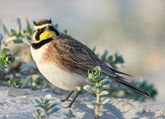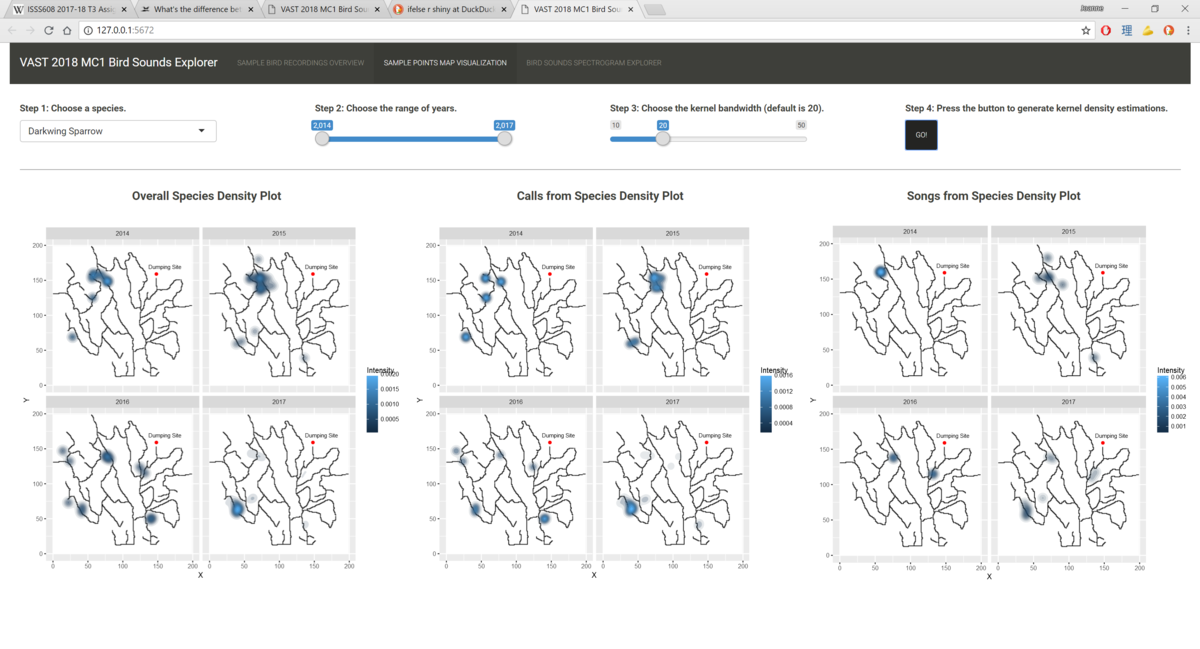ISSS608 2017-18 T3 Assign Tan Yong Ying Task 1 Insights
|
|
|
|
|
|
|
Using the bird call collection and the included map of the Wildlife Preserve, characterize the patterns of all of the bird species in the Preserve over the time of the collection. Please assume we have a reasonable distribution of sensors and human collectors providing the recordings, so that the patterns are reasonably representative of the bird locations across the area. Do you detect any trends or anomalies in the patterns? Please limit your answer to 10 images and 1000 words.
Note: Since we only have sufficient data points for most of the species from Year 2010 onwards, we will exclude any bird recordings before Year 2010. Also, as we have recordings only for Q1 in 2018, Year 2018 is also excluded from our analysis.
- Bent-beak Riffraff: They are predominantly found in the western region of the Preserve, but their hangout spots are not consistent through the years.
- Blue-collared Zipper: In Year 2014, they were only making calls and not songs. In Year 2015, they were not spotted in the Preserve at all. In Year 2016, they returned to the Preserve and went back to their favorite spot pre-2015.
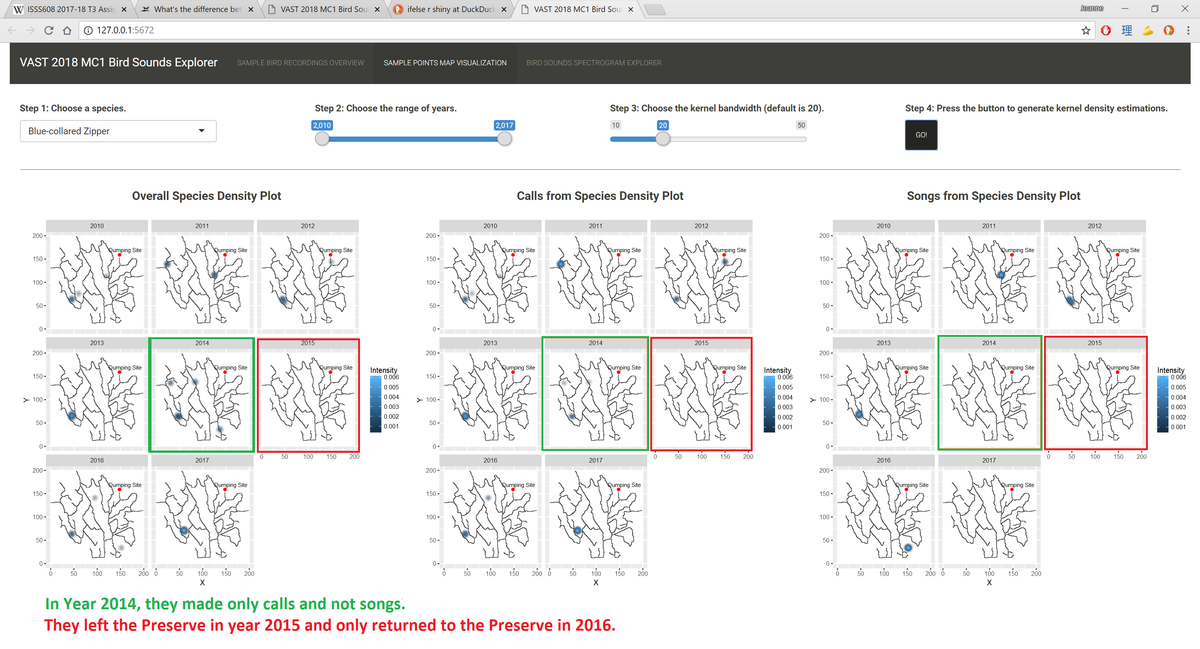
- Bombadil: They have stayed in the same location in the northeastern part of the Preserve between 2010 and 2017, and no major changes in their spatial distribution were observed.
- Broad-winged Jojo: They have a favorite spot at the southwestern part of the Preserve. There was an anomaly in year 2015, as high concentrations of them were found away from their favorite spot. They were only making calls and not songs. They returned to their favorite spot in Years 2016 and 2017, but overall their concentrations have dropped. This suggests that something may have happened in Year 2015 which caused them to stop singing, and subsequently experience a drop in their numbers overall.
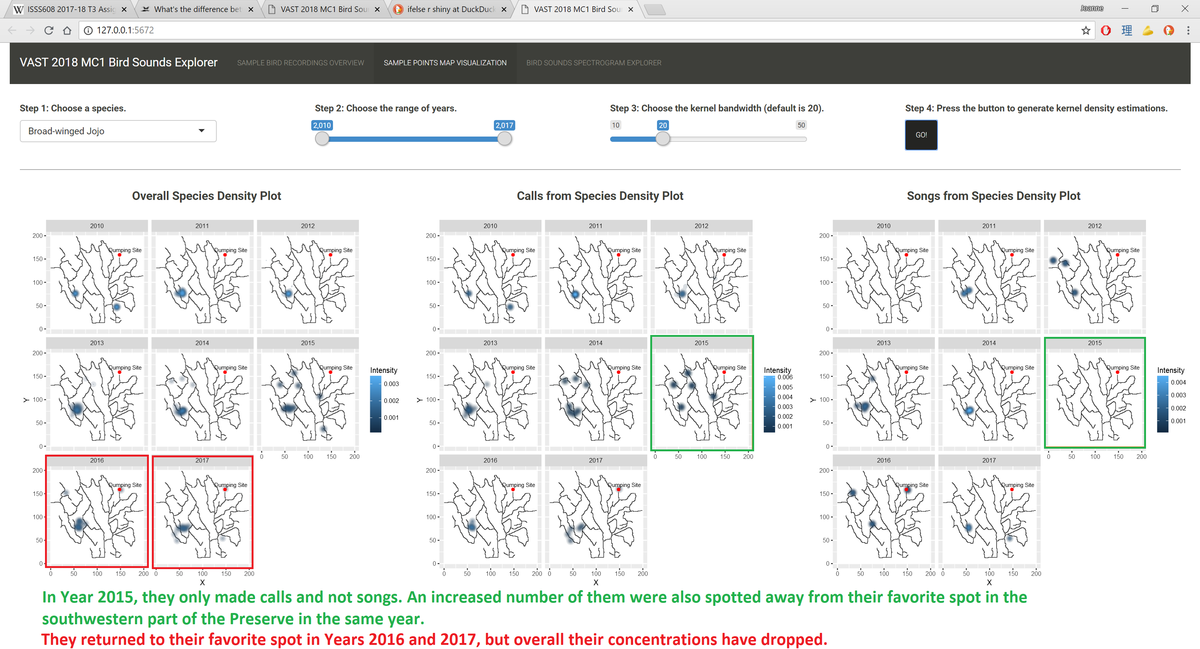
- Canadian Cootamum: They have a favorite spot in the northwestern part of the Preserve. No major changes in their spatial distribution were observed.
- Carries Champagne Pipit: They have a favorite spot at the southeastern part of the Preserve and had not moved away from it throughout the years. While they consistently make calls in that location each year, their songs are rare in general and they are found singing in different parts of the Preserve in different years.
- Darkwing Sparrow: They were only recorded from Year 2014 onwards. They had stayed in the northwestern part of the Preserve in Years 2014 and 2015, but their concentration there decreased in 2016 and they had mostly shifted away to the southwestern part of the Preserve in 2017. However, this observation may not be representative of the species’ activity since it only has four years of data as compared to other species with seven or eight years of data.
- Eastern Corn Skeet: They have a favorite spot near the center of the Preserve and have not moved away from it. Sometimes they are found singing in other parts of the Preserve.
- Green-tipped Scarlet Pipit: They have a favorite spot at the southwestern part of the Preserve. However, they are also regularly found in other parts of the Preserve in higher concentrations as compared to other species. However, there is a strange observation in Year 2015: while none of them were spotted at their favorite spot, there was a high number of them at the alleged dumping site. They returned to their spot in years 2016 and 2017, but their concentrations had started to drop in Year 2017. Something might have happened at the alleged site in 2015 which attracted their attention, but may have also caused the subsequent drop in their numbers.
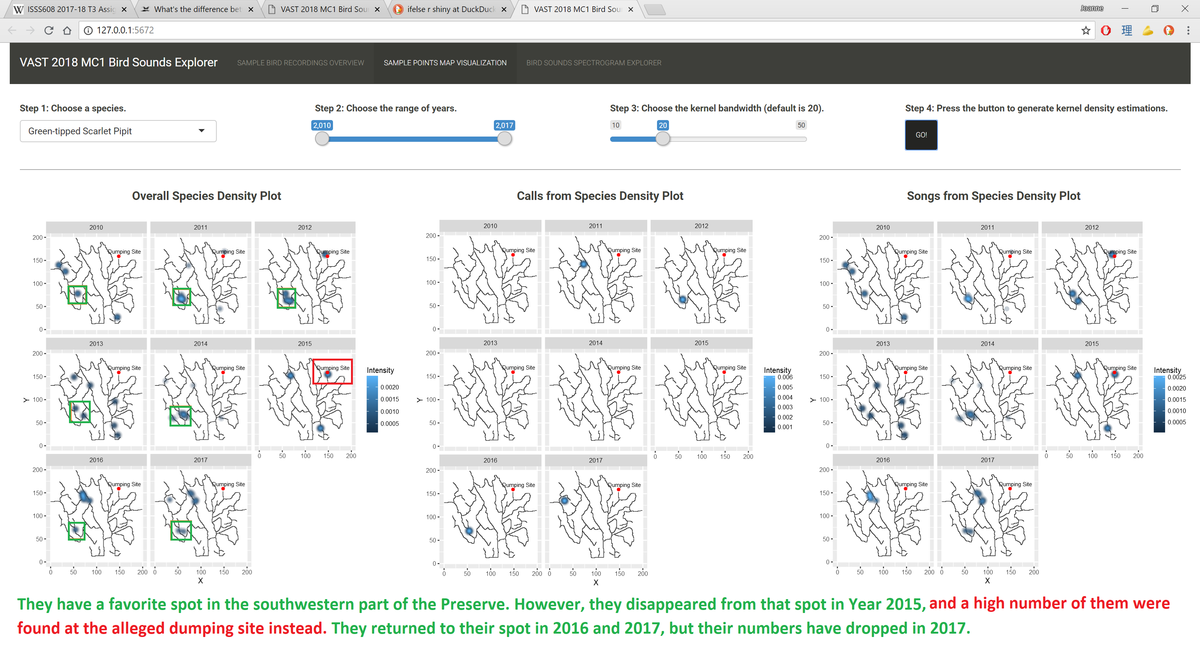
- Lesser Birchbeere: They have a main favorite spot in the southwestern region and a secondary favorite spot in the central eastern region. They are rarely found to be singing. No major changes in their spatial distribution or numbers were observed.
- Orange Pine Plover: Just like the Lesser Birchbeere, it has two favorite hangout spots, both located in the southern regions of the Preserve. They also do not see big changes in their spatial distribution or numbers. They seem to be close neighbors with the Lesser Birchbeere, as they are found in similar regions of the Preserve.
Insert gif here to switch between Lesser Birchbeere and Orange Pine Plover
- Ordinary Snape: They had stayed in the central-eastern part of the Preserve without moving and their numbers had remained consistent throughout the years.
- Pinkfinch: This species stands out because it does not stay in any spot regularly. Instead, they have been found throughout the Preserve at different locations each year. It is noted their numbers seem lower in years 2014, and decrease in their numbers are much more obvious in years 2016 and 2017.
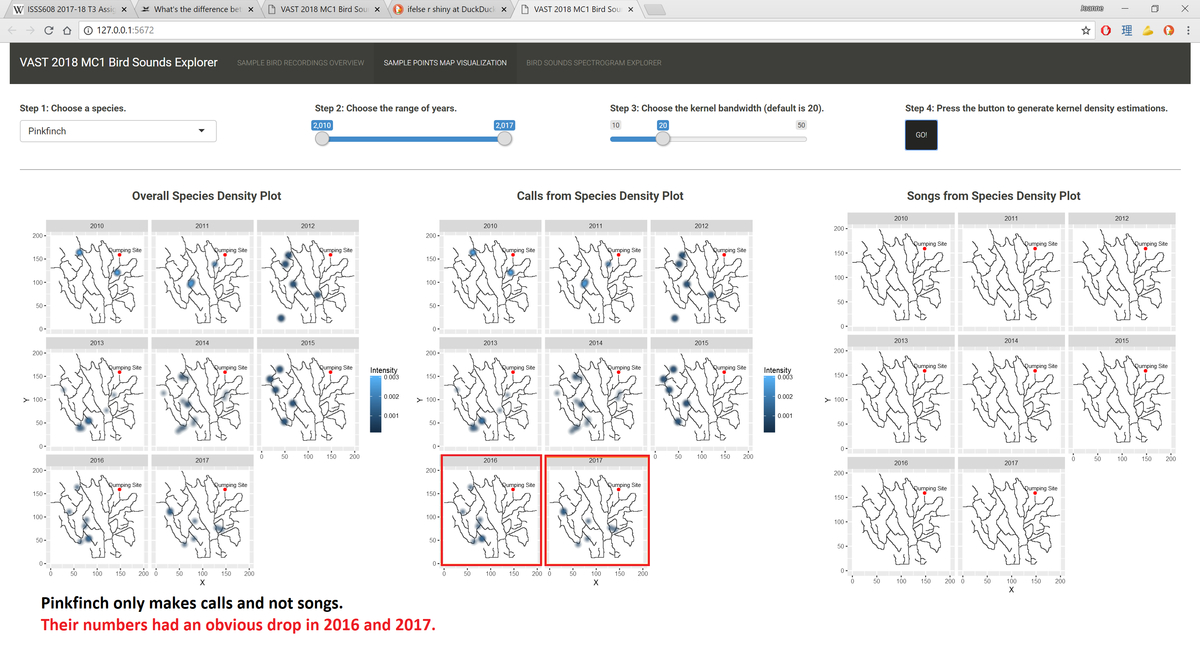
- Purple Tooting Tout: The recording distribution for this species has more anomalies than other species. Between Years 2010 to 2013, they were observed in one spot in the eastern region (orange rectangles), and observed in a bigger area in the western region (grey rectangles).
However, in year 2014, none were spotted in the eastern spot. In year 2015, none were spotted in the western region while they had returned to their western hangout region. After 2015, their overall numbers have dropped significantly throughout the Preserve. We also note that in years 2014 and 2015, their call distributions were concentrated on two point locations in the Preserve, which is an anomaly because their calls distributions were more widespread in other years.
Overall, these observations imply something might have happened in years 2014 and 2015 which resulted in the drastic change in their spatial distributions.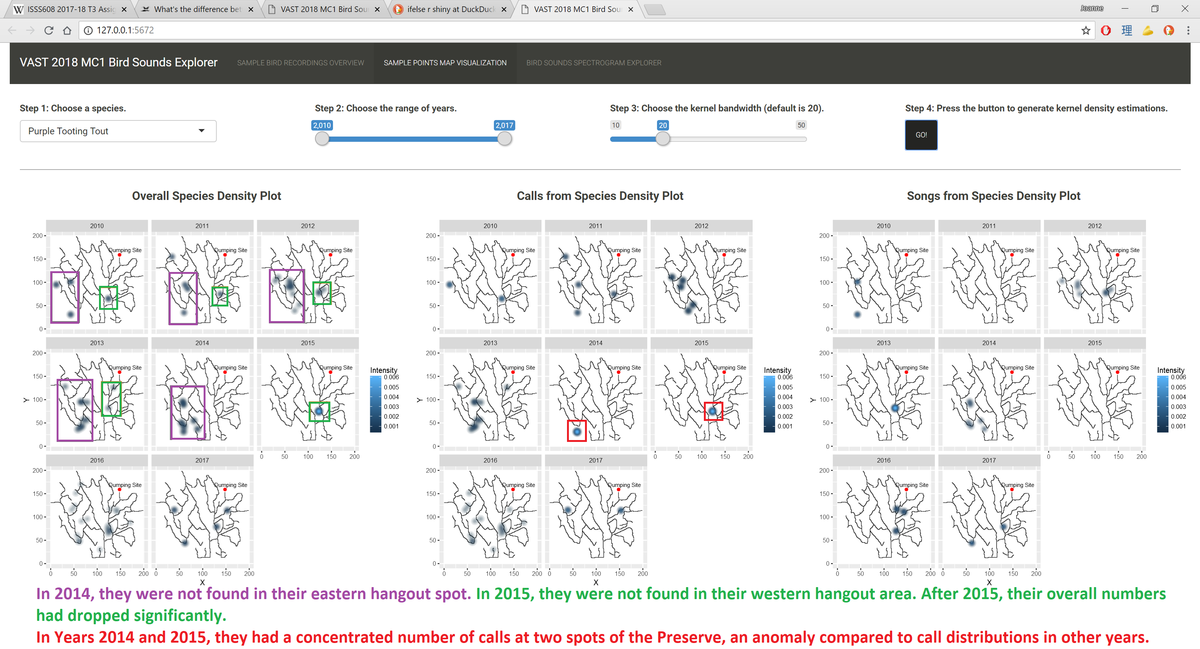
- Qax: They have one or two favorite spots near the central-western region. It seems that no major changes in their overall spatial distribution were observed. However, looking at the distribution of songs over time, we notice that they were not singing in 2014 as compared to other years. Once again, year 2014 has turned out to be a year full of "surprises".
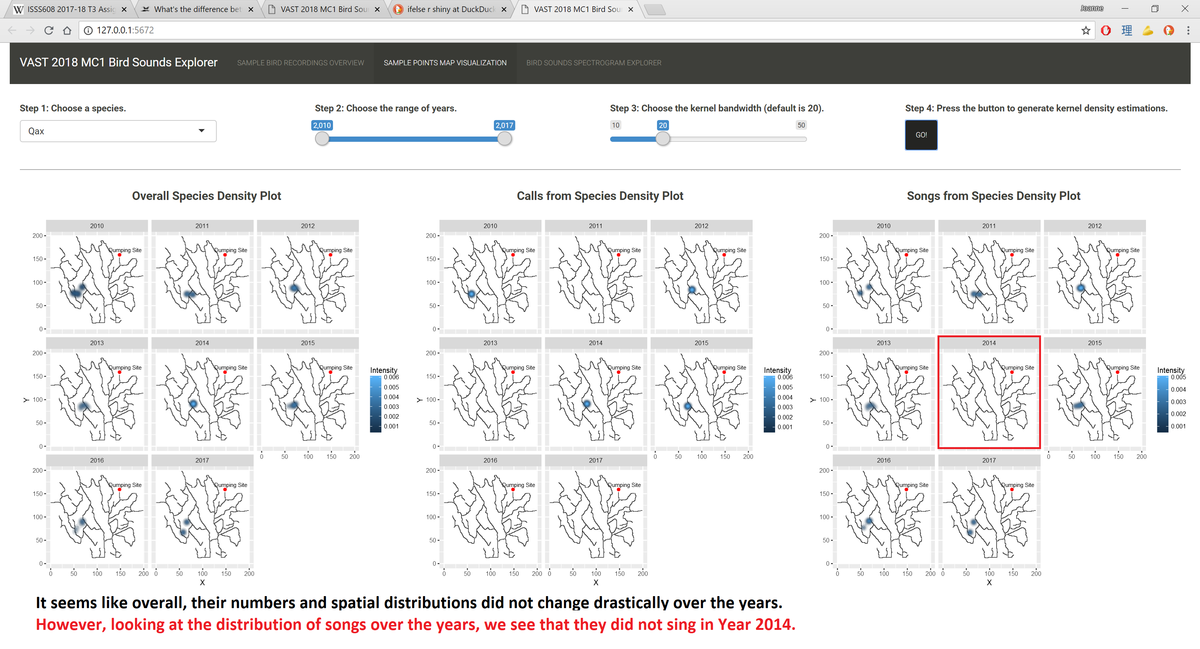
- Queenscoat: They are consistently found in the western regions of the Preserve without major changes in their spatial distribution. A small note is that their number of songs had obviously dropped in year 2015.
- Rose-crested Blue Pipit: They have two favorite spots in the north-eastern region of the Preserve; one spot is at the alleged dumping site and the other spot is below the site. Since 2015, they were no longer found at the alleged dumping site, and they were only spotted in their second favorite spot.
We also see that in Year 2014, the last year they were spotted at the alleged dumping site, they were only making calls and not singing.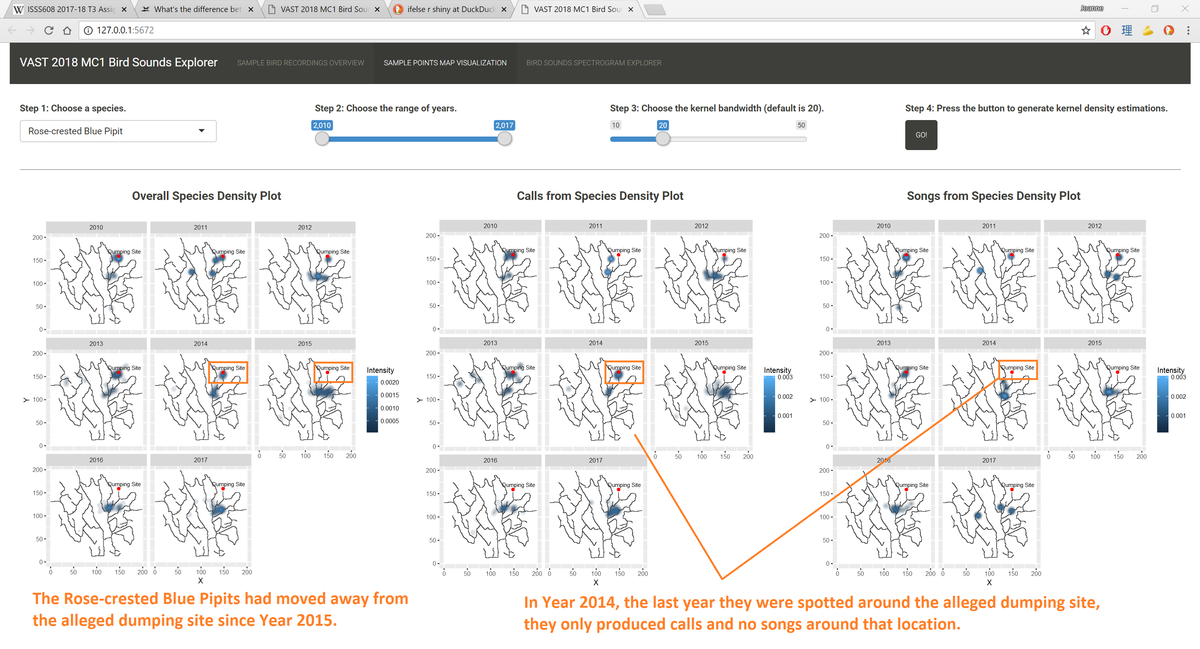
- Scrawny Jay: They have been consistently found in the western part of the Preserve, and it seems that overall, no major changes in their spatial distribution were observed. But once we break down the recordings into calls vs songs, the startling truth is that they have stopped singing entirely since year 2015. This also highlights the importance of a good visualization that allows the audience to see multiple angles of the situation in one unified view; the overall distribution alone may not tell the full story.
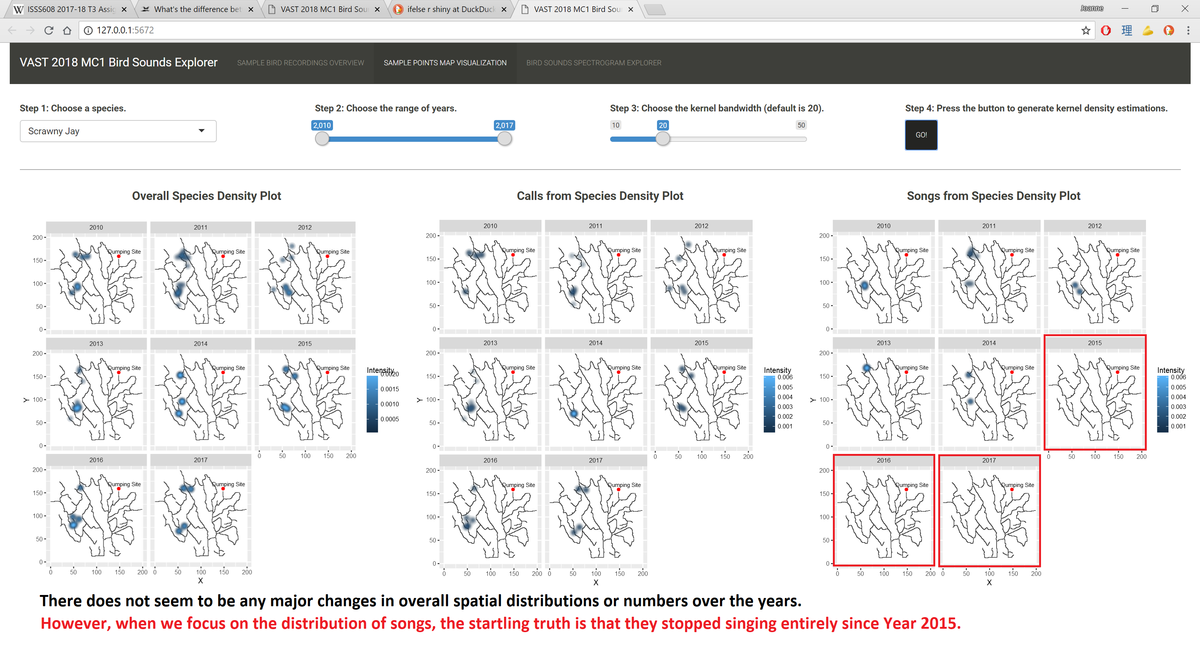
- Vermillion Trillian: They have been found in many locations around the Preserve across the years, with a favorite hangout spot in the northern region. No major changes in their spatial distribution or numbers were observed overall.
To summarize, these are the conclusions we can draw from the distribution of bird recordings between 2010 and 2017:
- Rose-crested Blue Pipits are the only species that had stayed at the alleged dumping site as a favorite hangout spot, but they had moved away from it since 2015.
- For all species with changes in spatial distribution, numbers and/or calls distribution and songs distribution, the changes happened in years 2014 and 2015, which suggests something might have happened in the Preserve which resulted in these changes in 8 out of 19 species. 7 out of the 8 species saw a drop in numbers, a big change in spatial distribution or a big change in their call/songs distribution. The Green-tipped Scarlet Pipit saw a change in spatial distribution in Year 2015, during which they concentrated at the alleged dumping site.
- This table classifies the 19 species by four categories: Consistent distribution without change in distribution and/or numbers, consistent distribution with change in distribution and/or numbers, inconsistent distribution without change in distribution and/or numbers, inconsistent distribution with change in distribution and/or numbers
| Without Change | With Change | |
|---|---|---|
| Consistent Spatial Distribution | Bombadil Canadian Cootamum Carries Champagne Pipit Eastern Corn Skeet Lesser Birchbeere Orange Pine Plover Ordinary Snape Queenscoat Vermillion Trillian |
Blue-collared zipper Broad-winged Jojo Green-tipped Scarlet Pipit Pinkfinch Purple Tooting Tout Qax Rose-crested Blue Pipit Scrawny Jay |
| Inconsistent Spatial Distribution | Bent-beak Riffraff | Darkwing Sparrow (4 years of data only) |
Banner image credit to: Marshal Hedin
